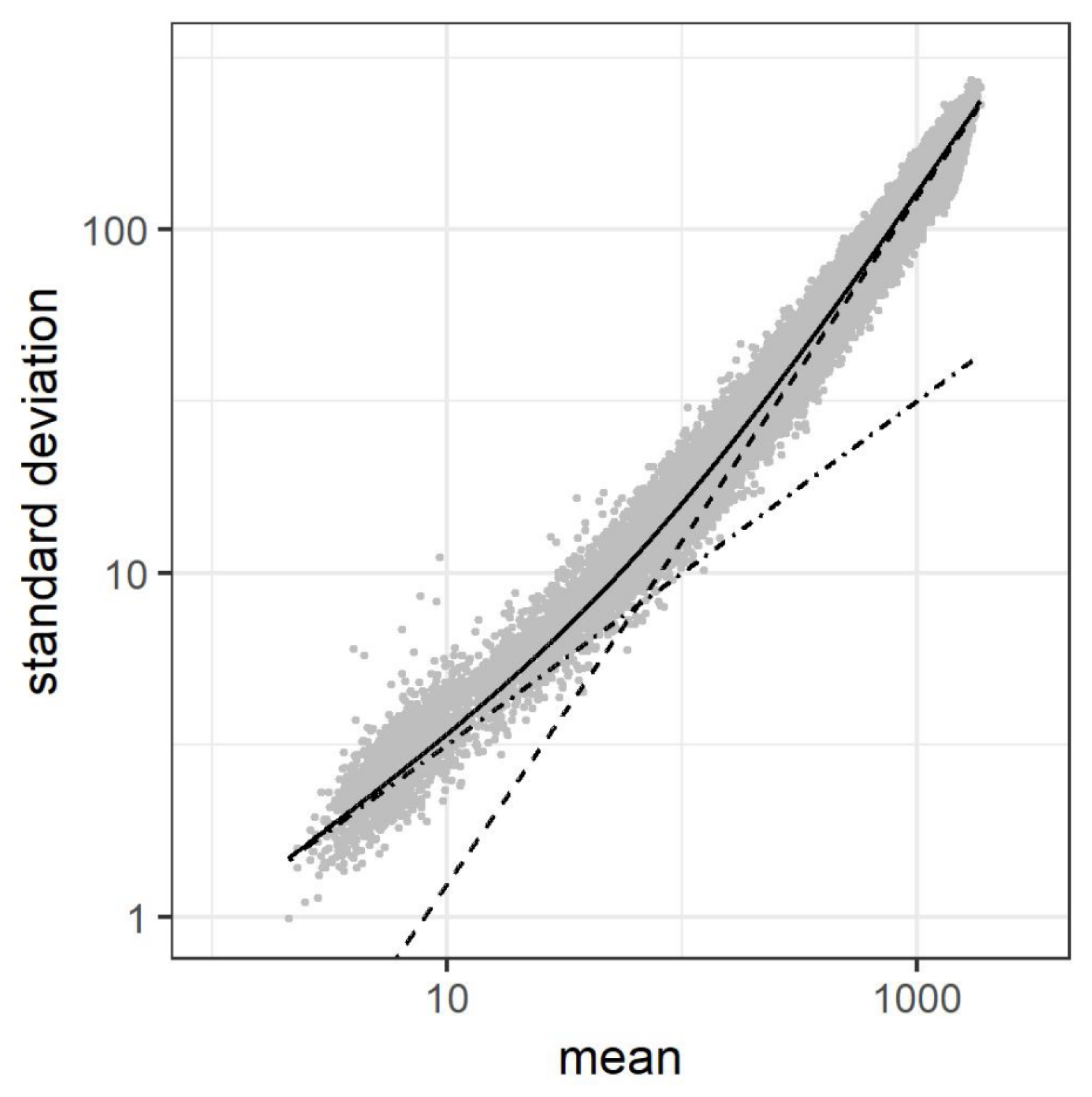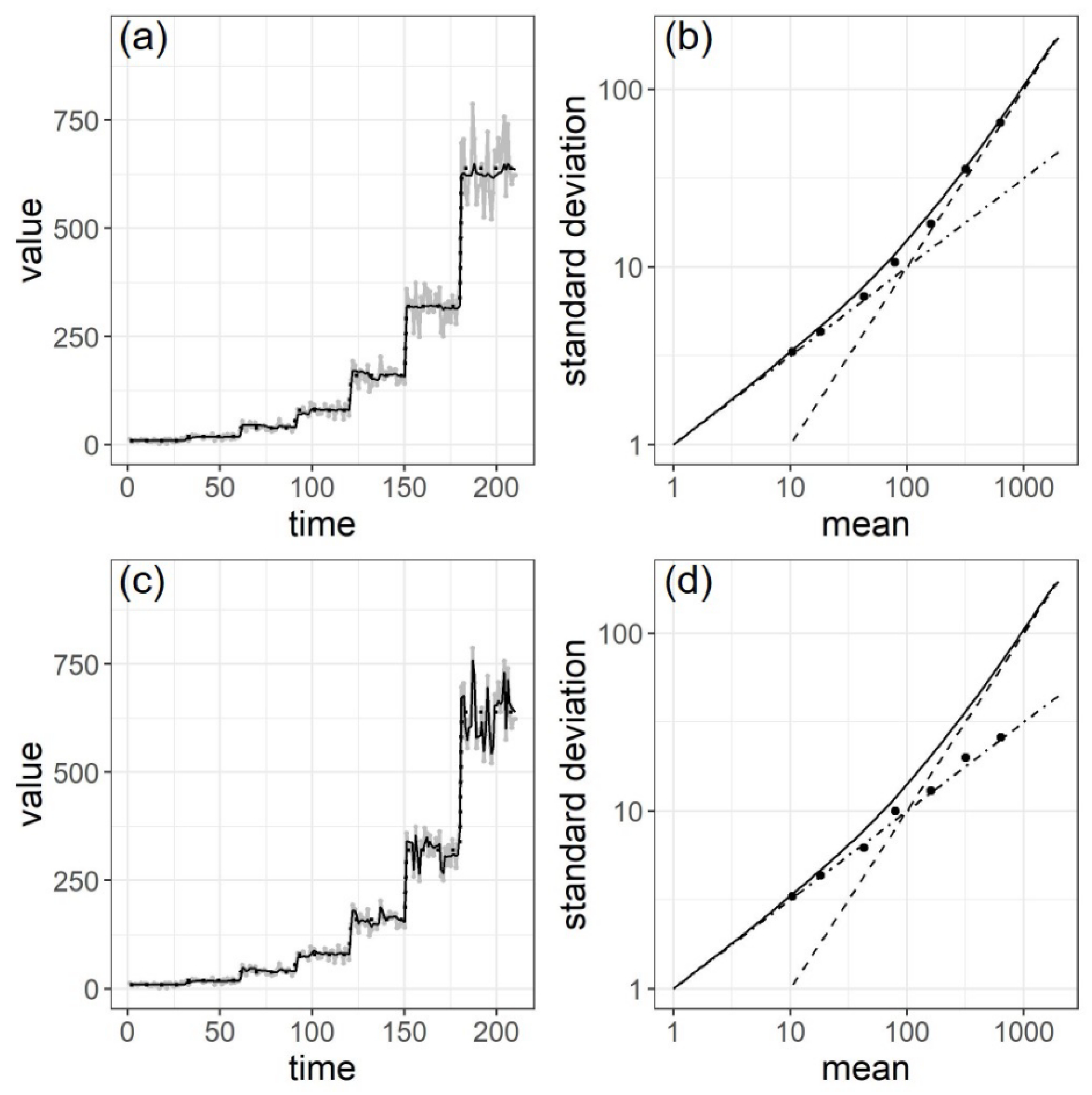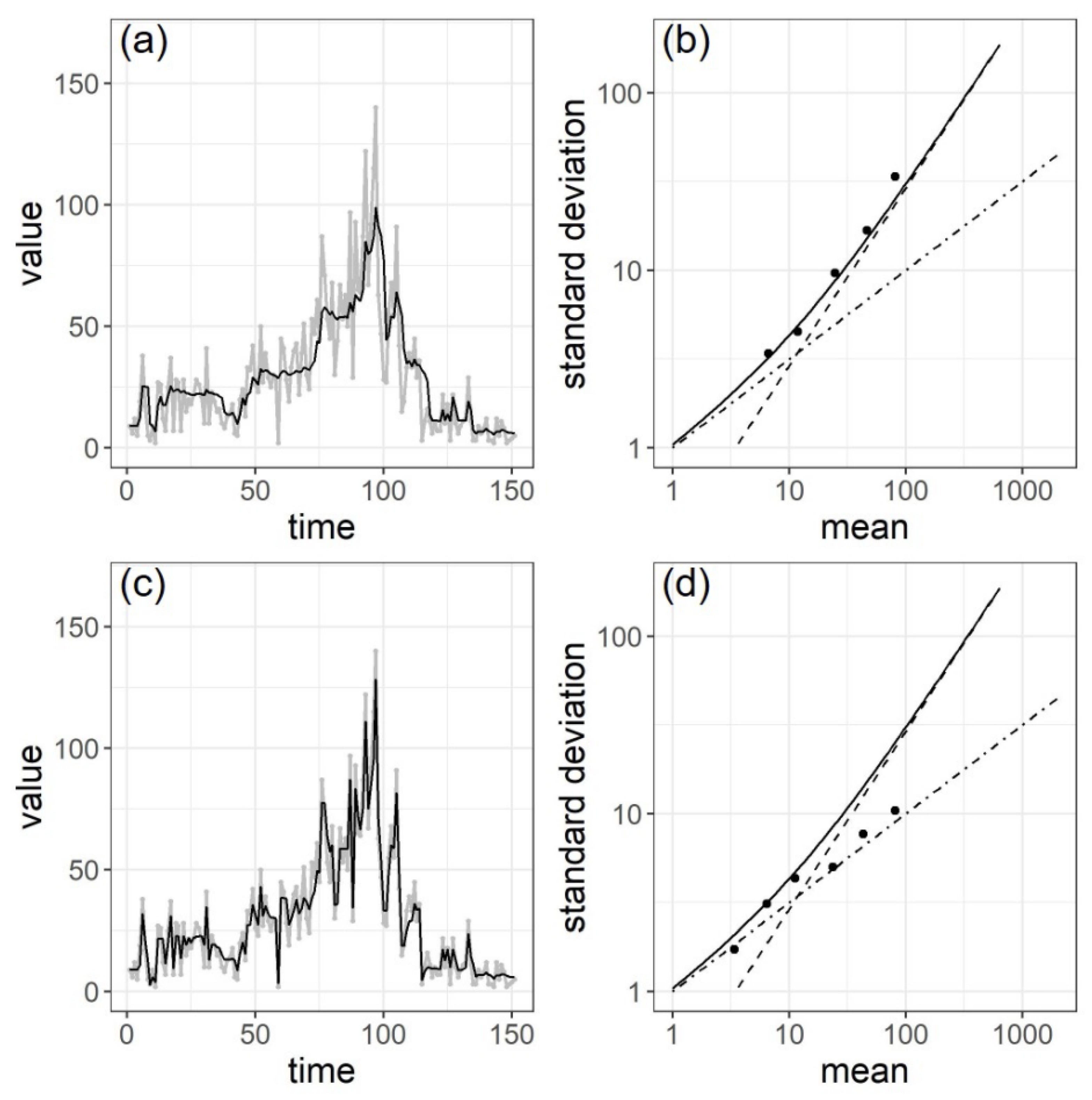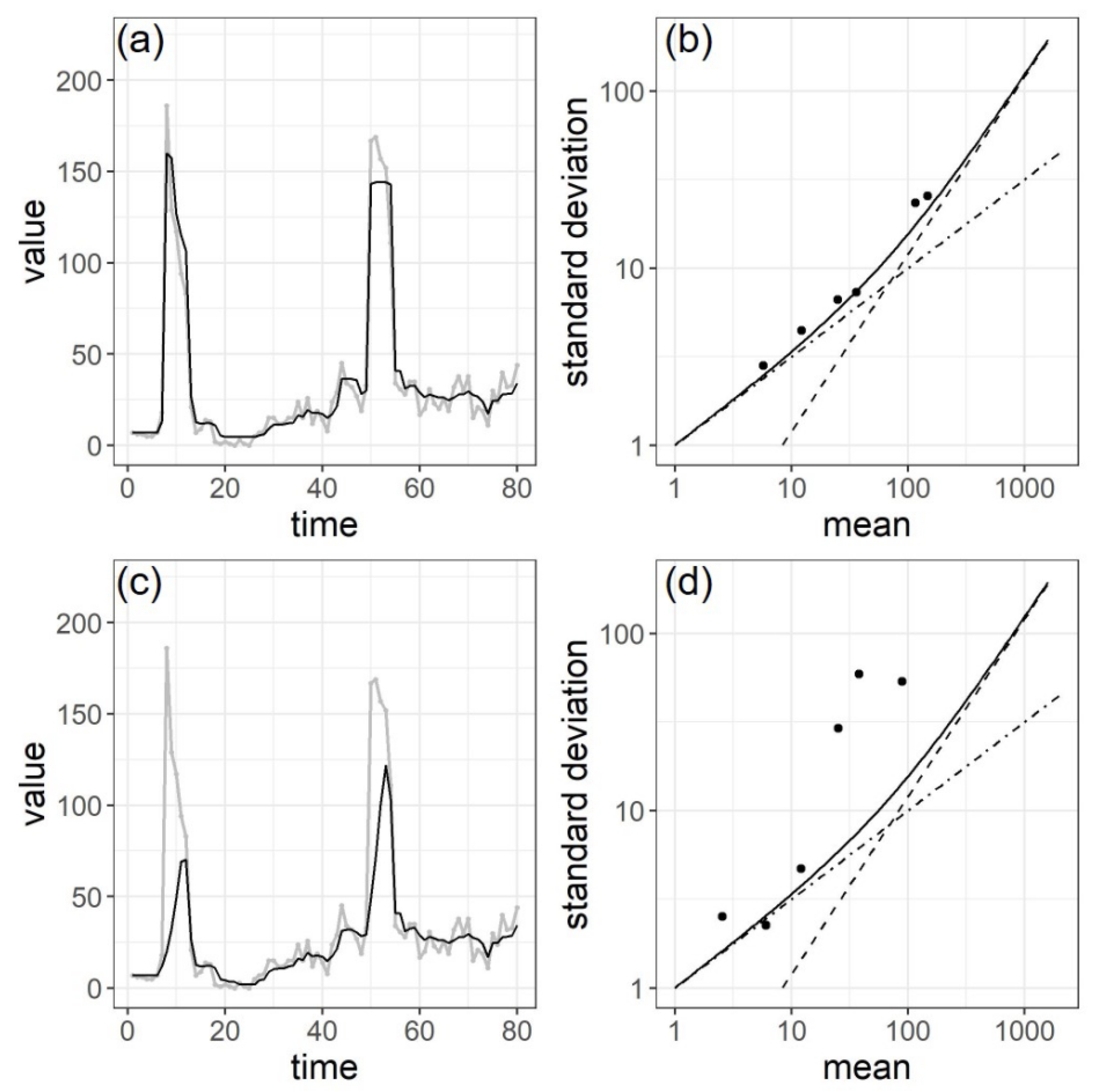Tracking Poisson Parameter for Non-Stationary Discontinuous Time Series with Taylor’s Abnormal Fluctuation Scaling
Abstract
:1. Introduction
2. Methods
2.1. Non-Stationary Time Series Analysis
2.2. Taylor’s Fluctuation Scaling Law
- For small mean values we prepare data sets of daily sales numbers of the product for each store with specification by the day of the week (For example, sales number in every Monday). 243 (stores) × 7 (days of the week) = 1701 points are plotted.
- For larger mean values we prepare aggregated data sets by random sampling as follows. For each given number of stores, k, we choose k stores at random and the sales numbers are summed up for each day of the week. The value of k is from 2 to 243 and we repeat this procedure 30 times for each k (48,223 points are plotted.)
2.3. SSM of Our Method
2.4. Particle Filter
- Generate initial N particles and set .
- At time t:
- (a)
- (b)
- Using the observation value , estimate likelihood for each particle by Equation (9)
- (c)
- Update particles by resampling with the replacement of . The resampling probabilities for each particle are proportional to the likelihood of each particle.
- (d)
- If time t is the last step, stop the procedure. Otherwise, increment t and go to step 2 (a).
2.5. Particle Filter with Discontinuity Detection
- Detect a discontinuous point by checking whether the observation value is out of the bound of the particle distribution.
- If a discontinuous point is detected, initialize the particle distribution with the observation value at the discontinuous point.
- Generate initial N particles , set .
- At time t:
- (a)
- (b)
- If the observation value is above the upper bound or below the lower bound of the prediction distribution, go to step 1 and set to or at the upward or downward discontinuous point respectively. Otherwise, using the observation value , estimate likelihood for each particle by Equation (9) and go to next step .
- (c)
- Update particles by resampling with the replacement of . The resampling probabilities for each particle are proportional to the likelihood of each particle.
- (d)
- If time t is the last step, stop the procedure. Otherwise, increment t and go to step 2 (a).
2.6. Summary of the Parameter Estimation Procedure
- Estimate the proportional constant of Taylor’s fluctuation scaling by some previous data, as explained in Section 2.2.
- Apply the Particle filter described in Section 2.4 and Section 2.5 to solve the SSM, and estimate Poisson parameter of a time series. Poisson parameter is estimated basically based on the likelihood for an observation data at each time t. When the discontinuous trend jump is detected as explained in Section 2.5, the value of is estimated based on the observation data. No extrapolation is done, namely, we do not estimate the parameter where there is no data.
3. Simulation Tests
3.1. Validity for Non-Stationarity
3.2. Validity for Taylor’s Fluctuation Scaling
- Make pairs of estimated values of and time series value for each time t.
- Divide the pairs into groups by exponential bins such as for estimated values of values.
- Calculate the standard deviation with the time series value and estimated values of for each group. Obtain the mean with the estimated values of for each group.
4. Point-of-Sales (POS) Data Tests
5. Conclusions
Author Contributions
Funding
Acknowledgments
Conflicts of Interest
Appendix A. Estimation of the Hyper Parameters



References
- Fukunaga, G.; Takayasu, H.; Takayasu, M. Property of Fluctuations of Sales Quantities by Product Category in Convenience Stores. PLoS ONE 2016, 11, e0157653. [Google Scholar] [CrossRef] [PubMed]
- Azevedo, R.B.R.; Leroi, A.M. The flux-dependent amplitude of broadband noise variability in X-ray binaries and active galaxies. Mon. Not. R. Astron. Soc. 2001, 323, L26–L30. [Google Scholar]
- Turchin, P.; Taylor, A.D. Complex Dynamics in Ecological Time Series. Ecology 1992, 73, 289–305. [Google Scholar] [CrossRef] [Green Version]
- De Menezes, M.A.; Barabási, A.-L. Separating Internal and External Dynamics of Complex Systems. Phys. Rev. Lett. 2004, 93, 068701. [Google Scholar] [CrossRef] [PubMed]
- Winkelmann, R. Econometric Analysis of Count Data; Springer: Berlin/Heidelberg, Germany, 2008; pp. 63–126. [Google Scholar]
- Taylor, L.R. Aggregation, variance and the mean. Nature 1961, 189, 732–735. [Google Scholar] [CrossRef]
- Eisler, Z.; Bartos, I.; Kertész, J. Fluctuation scaling in complex systems: Tayolr’s law and beyond. Adv. Phys. 2008, 57, 89. [Google Scholar] [CrossRef]
- Kendal, W.S. A frequency distribution for the number of hematogenous organ metastases. J. Theor. Biol. 2002, 217, 203–218. [Google Scholar] [CrossRef]
- Eisler, Z.; Kertész, J. Scaling theory of temporal correlations and size-dependent fluctuations in the traded value of stocks. Phys. Rev. E. 2006, 73, 046109. [Google Scholar] [CrossRef]
- De Menezes, M.A.; Barabási, A.-L. Fluctuations in network dynamics. Phys. Rev. Lett. 2004, 92, 028701. [Google Scholar] [CrossRef]
- Sano, Y.; Yamada, K.; Watanabe, H.; Takayasu, H.; Takayasu, M. Empirical analysis of collective human behavior for extraordinary events in the blogosphere. Phys. Rev. E. 2013, 87, 012805. [Google Scholar] [CrossRef]
- Meloni, S.; Gomez-Gardeñes, J.; Latora, V.; Moreno, Y. Scaling Breakdown in Flow Fluctuations on Complex Networks. Phys. Rev. Lett. 2008, 100, 208701. [Google Scholar] [CrossRef] [PubMed]
- Box, G.; Jenkins, G. Time Series Analysis: Forecasting and Control; Holden-Day: San Francisco, CA, USA, 1976. [Google Scholar]
- Zhang, G.P. Neural Networks for Time-Series Forecasting, Handbook of Natural Computing; Springer: Berlin/Heidelberg, Germany, 2012; pp. 461–477. [Google Scholar]
- Hastie, T.; Tibshirani, R. Generalized Additive Models; Chapman and Hall: London, UK, 1990. [Google Scholar]
- Harvey, A. Forecasting with Unobserved Components Time Series Models, Handbook of Economic Forecasting; Elsevier: Amsterdam, The Netherlands, 2006. [Google Scholar]
- Yura, Y.; Takayasu, H.; Nakamura, K.; Takayasu, M. Rapid Detection of the Switching Point in a Financial Market Structure Using the Particle Filter. J. Stat. Comput. Simul. 2014, 84, 2073–2090. [Google Scholar] [CrossRef]
- Watanabe, H.; Sano, Y.; Takayasu, H.; Takayasu, M. Statistical properties of fluctuations of time series representing appearances of words in nationwide blog data and their applications: An example of modeling fluctuation scalings of nonstationary time series. Phys. Rev. E 2016, 94, 052317. [Google Scholar] [CrossRef]
- Draper, N.R.; Smith, H. Applied Regression Analysis; Wiley: Hoboken, NJ, USA, 1998; pp. 505–565. [Google Scholar]
- Cherry, S.R.; Sorenson, J.A.; Phelps, M.E. Physics in Nuclear Medicine, 4th ed.; Elsevier: Amsterdam, The Netherlands, 2012; pp. 126–128. [Google Scholar]
- Kitagawa, G. Monte Carlo Filter and Smoother for Non-Gaussian Nonlinear State Space Models. J. Comput. Graph. Stat. 1996, 5, 1–25. [Google Scholar]
- Gordon, N.J.; Salmond, D.J.; Smith, A.F. Novel approach to nonlinear/non-Gaussian Bayesian state estimation. IEE Proc. F-Radar Signal Process. 1993, 140, 107–113. [Google Scholar] [CrossRef]
- Liu, J.S. Monte Carlo Strategies in Scientific Computing; Springer: Berlin, Germany, 2001. [Google Scholar]
- Luc, D. Non-Uniform Random Variate Generation; Springer: Berlin/Heidelberg, Germany, 1986; pp. 27–36. [Google Scholar]
- Azevedo, R.B.R.; Leroi, A.M. A power law for cells. Proc. Natl. Acad. Sci. USA 2001, 98, 5699–5704. [Google Scholar] [CrossRef] [PubMed] [Green Version]
- Jánosi, I.M.; Gallas, J.A.C. Growth of companies and water-level uctuations of the river Danube. Physica A 1999, 271, 448–457. [Google Scholar] [CrossRef]
- Cerqueti, R.; Fenga LVentura, M. Does the U.S. exercise contagion on Italy? A theoretical model and empirical evidence. Physica A 2018, 499, 436–442. [Google Scholar] [CrossRef]
- Cerqueti, R.; Ventura, M. Risk and Uncertainty in the Patent Race: A Probabilistic Model. IMA J. Manag. Math. 2015, 26, 39–62. [Google Scholar] [CrossRef]
- Cerqueti, R.; Ventura, M. Patent Valuation Under Spatial Point Processes with Delayed and Decreasing Jump Intensity. BE J. Theor. Econ. 2015, 15, 433–456. [Google Scholar] [CrossRef]
- Cerqueti, R. Exhaustion of Resources: A Marked Temporal Process Framework. Stoch. Environ. Res. Risk Assess. 2014, 28, 1023–1033. [Google Scholar] [CrossRef]
- Cerqueti, R.; Foschi, R.; Spizzichino, F. A Spatial Mixed Poisson Framework for Combination of Excess of Loss and Proportional Reinsurance Contracts. Insur. Math. Econ. 2009, 45, 59–64. [Google Scholar] [CrossRef]
- Kitagawa, G. A self-organizing state-space model. J. Am. Stat. Assoc. 1998, 93, 1203–1215. [Google Scholar] [CrossRef]







© 2019 by the authors. Licensee MDPI, Basel, Switzerland. This article is an open access article distributed under the terms and conditions of the Creative Commons Attribution (CC BY) license (http://creativecommons.org/licenses/by/4.0/).
Share and Cite
Sakoda, G.; Takayasu, H.; Takayasu, M. Tracking Poisson Parameter for Non-Stationary Discontinuous Time Series with Taylor’s Abnormal Fluctuation Scaling. Stats 2019, 2, 55-69. https://doi.org/10.3390/stats2010005
Sakoda G, Takayasu H, Takayasu M. Tracking Poisson Parameter for Non-Stationary Discontinuous Time Series with Taylor’s Abnormal Fluctuation Scaling. Stats. 2019; 2(1):55-69. https://doi.org/10.3390/stats2010005
Chicago/Turabian StyleSakoda, Gen, Hideki Takayasu, and Misako Takayasu. 2019. "Tracking Poisson Parameter for Non-Stationary Discontinuous Time Series with Taylor’s Abnormal Fluctuation Scaling" Stats 2, no. 1: 55-69. https://doi.org/10.3390/stats2010005




